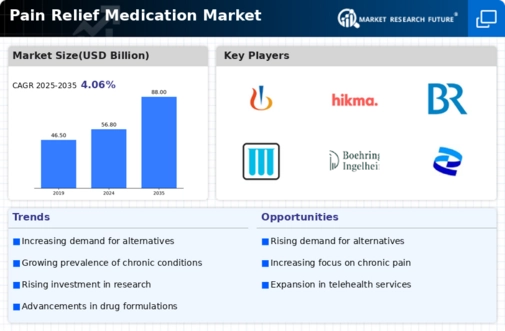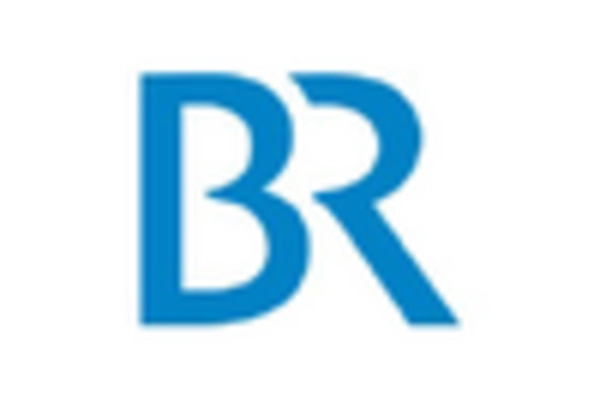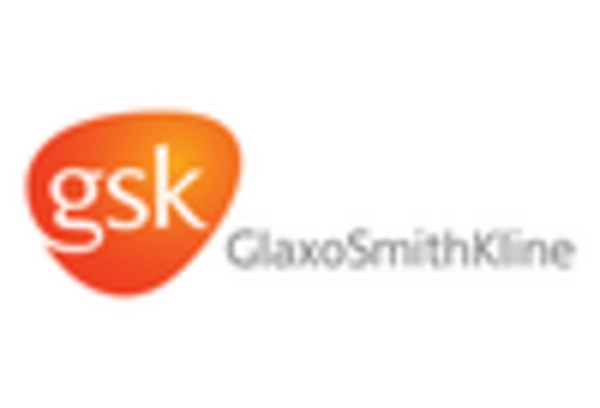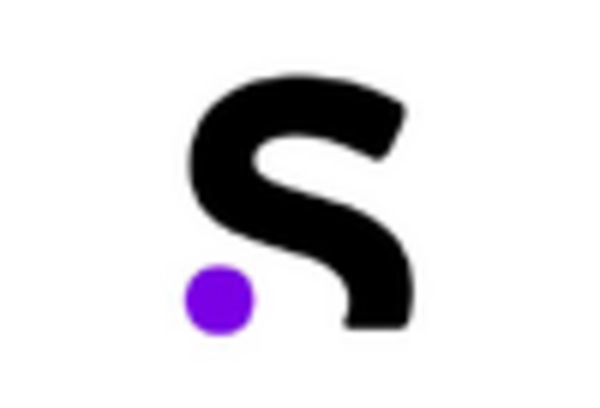Non-Steroidal Anti-Inflammatory Drugs
Acetaminophen
Opioids
Adjuvant Analgesics
Tablets
Capsules
Liquid
Topical
Oral
Topical
Injectable
Transdermal
Chronic Pain
Acute Pain
Postoperative Pain
Cancer Pain
North America
Europe
South America
Asia Pacific
Middle East and Africa
North America Outlook (USD Billion, 2019-2035)
North America Pain Relief Medication Market by Medication Type
Non-Steroidal Anti-Inflammatory Drugs
Acetaminophen
Opioids
Adjuvant Analgesics
North America Pain Relief Medication Market by Formulation Type
Tablets
Capsules
Liquid
Topical
North America Pain Relief Medication Market by Route of Administration Type
Oral
Topical
Injectable
Transdermal
North America Pain Relief Medication Market by Therapeutic Area Type
Chronic Pain
Acute Pain
Postoperative Pain
Cancer Pain
North America Pain Relief Medication Market by Regional Type
US
Canada
US Outlook (USD Billion, 2019-2035)
US Pain Relief Medication Market by Medication Type
Non-Steroidal Anti-Inflammatory Drugs
Acetaminophen
Opioids
Adjuvant Analgesics
US Pain Relief Medication Market by Formulation Type
Tablets
Capsules
Liquid
Topical
US Pain Relief Medication Market by Route of Administration Type
Oral
Topical
Injectable
Transdermal
US Pain Relief Medication Market by Therapeutic Area Type
Chronic Pain
Acute Pain
Postoperative Pain
Cancer Pain
CANADA Outlook (USD Billion, 2019-2035)
CANADA Pain Relief Medication Market by Medication Type
Non-Steroidal Anti-Inflammatory Drugs
Acetaminophen
Opioids
Adjuvant Analgesics
CANADA Pain Relief Medication Market by Formulation Type
Tablets
Capsules
Liquid
Topical
CANADA Pain Relief Medication Market by Route of Administration Type
Oral
Topical
Injectable
Transdermal
CANADA Pain Relief Medication Market by Therapeutic Area Type
Chronic Pain
Acute Pain
Postoperative Pain
Cancer Pain
Europe Outlook (USD Billion, 2019-2035)
Europe Pain Relief Medication Market by Medication Type
Non-Steroidal Anti-Inflammatory Drugs
Acetaminophen
Opioids
Adjuvant Analgesics
Europe Pain Relief Medication Market by Formulation Type
Tablets
Capsules
Liquid
Topical
Europe Pain Relief Medication Market by Route of Administration Type
Oral
Topical
Injectable
Transdermal
Europe Pain Relief Medication Market by Therapeutic Area Type
Chronic Pain
Acute Pain
Postoperative Pain
Cancer Pain
Europe Pain Relief Medication Market by Regional Type
Germany
UK
France
Russia
Italy
Spain
Rest of Europe
GERMANY Outlook (USD Billion, 2019-2035)
GERMANY Pain Relief Medication Market by Medication Type
Non-Steroidal Anti-Inflammatory Drugs
Acetaminophen
Opioids
Adjuvant Analgesics
GERMANY Pain Relief Medication Market by Formulation Type
Tablets
Capsules
Liquid
Topical
GERMANY Pain Relief Medication Market by Route of Administration Type
Oral
Topical
Injectable
Transdermal
GERMANY Pain Relief Medication Market by Therapeutic Area Type
Chronic Pain
Acute Pain
Postoperative Pain
Cancer Pain
UK Outlook (USD Billion, 2019-2035)
UK Pain Relief Medication Market by Medication Type
Non-Steroidal Anti-Inflammatory Drugs
Acetaminophen
Opioids
Adjuvant Analgesics
UK Pain Relief Medication Market by Formulation Type
Tablets
Capsules
Liquid
Topical
UK Pain Relief Medication Market by Route of Administration Type
Oral
Topical
Injectable
Transdermal
UK Pain Relief Medication Market by Therapeutic Area Type
Chronic Pain
Acute Pain
Postoperative Pain
Cancer Pain
FRANCE Outlook (USD Billion, 2019-2035)
FRANCE Pain Relief Medication Market by Medication Type
Non-Steroidal Anti-Inflammatory Drugs
Acetaminophen
Opioids
Adjuvant Analgesics
FRANCE Pain Relief Medication Market by Formulation Type
Tablets
Capsules
Liquid
Topical
FRANCE Pain Relief Medication Market by Route of Administration Type
Oral
Topical
Injectable
Transdermal
FRANCE Pain Relief Medication Market by Therapeutic Area Type
Chronic Pain
Acute Pain
Postoperative Pain
Cancer Pain
RUSSIA Outlook (USD Billion, 2019-2035)
RUSSIA Pain Relief Medication Market by Medication Type
Non-Steroidal Anti-Inflammatory Drugs
Acetaminophen
Opioids
Adjuvant Analgesics
RUSSIA Pain Relief Medication Market by Formulation Type
Tablets
Capsules
Liquid
Topical
RUSSIA Pain Relief Medication Market by Route of Administration Type
Oral
Topical
Injectable
Transdermal
RUSSIA Pain Relief Medication Market by Therapeutic Area Type
Chronic Pain
Acute Pain
Postoperative Pain
Cancer Pain
ITALY Outlook (USD Billion, 2019-2035)
ITALY Pain Relief Medication Market by Medication Type
Non-Steroidal Anti-Inflammatory Drugs
Acetaminophen
Opioids
Adjuvant Analgesics
ITALY Pain Relief Medication Market by Formulation Type
Tablets
Capsules
Liquid
Topical
ITALY Pain Relief Medication Market by Route of Administration Type
Oral
Topical
Injectable
Transdermal
ITALY Pain Relief Medication Market by Therapeutic Area Type
Chronic Pain
Acute Pain
Postoperative Pain
Cancer Pain
SPAIN Outlook (USD Billion, 2019-2035)
SPAIN Pain Relief Medication Market by Medication Type
Non-Steroidal Anti-Inflammatory Drugs
Acetaminophen
Opioids
Adjuvant Analgesics
SPAIN Pain Relief Medication Market by Formulation Type
Tablets
Capsules
Liquid
Topical
SPAIN Pain Relief Medication Market by Route of Administration Type
Oral
Topical
Injectable
Transdermal
SPAIN Pain Relief Medication Market by Therapeutic Area Type
Chronic Pain
Acute Pain
Postoperative Pain
Cancer Pain
REST OF EUROPE Outlook (USD Billion, 2019-2035)
REST OF EUROPE Pain Relief Medication Market by Medication Type
Non-Steroidal Anti-Inflammatory Drugs
Acetaminophen
Opioids
Adjuvant Analgesics
REST OF EUROPE Pain Relief Medication Market by Formulation Type
Tablets
Capsules
Liquid
Topical
REST OF EUROPE Pain Relief Medication Market by Route of Administration Type
Oral
Topical
Injectable
Transdermal
REST OF EUROPE Pain Relief Medication Market by Therapeutic Area Type
Chronic Pain
Acute Pain
Postoperative Pain
Cancer Pain
APAC Outlook (USD Billion, 2019-2035)
APAC Pain Relief Medication Market by Medication Type
Non-Steroidal Anti-Inflammatory Drugs
Acetaminophen
Opioids
Adjuvant Analgesics
APAC Pain Relief Medication Market by Formulation Type
Tablets
Capsules
Liquid
Topical
APAC Pain Relief Medication Market by Route of Administration Type
Oral
Topical
Injectable
Transdermal
APAC Pain Relief Medication Market by Therapeutic Area Type
Chronic Pain
Acute Pain
Postoperative Pain
Cancer Pain
APAC Pain Relief Medication Market by Regional Type
China
India
Japan
South Korea
Malaysia
Thailand
Indonesia
Rest of APAC
CHINA Outlook (USD Billion, 2019-2035)
CHINA Pain Relief Medication Market by Medication Type
Non-Steroidal Anti-Inflammatory Drugs
Acetaminophen
Opioids
Adjuvant Analgesics
CHINA Pain Relief Medication Market by Formulation Type
Tablets
Capsules
Liquid
Topical
CHINA Pain Relief Medication Market by Route of Administration Type
Oral
Topical
Injectable
Transdermal
CHINA Pain Relief Medication Market by Therapeutic Area Type
Chronic Pain
Acute Pain
Postoperative Pain
Cancer Pain
INDIA Outlook (USD Billion, 2019-2035)
INDIA Pain Relief Medication Market by Medication Type
Non-Steroidal Anti-Inflammatory Drugs
Acetaminophen
Opioids
Adjuvant Analgesics
INDIA Pain Relief Medication Market by Formulation Type
Tablets
Capsules
Liquid
Topical
INDIA Pain Relief Medication Market by Route of Administration Type
Oral
Topical
Injectable
Transdermal
INDIA Pain Relief Medication Market by Therapeutic Area Type
Chronic Pain
Acute Pain
Postoperative Pain
Cancer Pain
JAPAN Outlook (USD Billion, 2019-2035)
JAPAN Pain Relief Medication Market by Medication Type
Non-Steroidal Anti-Inflammatory Drugs
Acetaminophen
Opioids
Adjuvant Analgesics
JAPAN Pain Relief Medication Market by Formulation Type
Tablets
Capsules
Liquid
Topical
JAPAN Pain Relief Medication Market by Route of Administration Type
Oral
Topical
Injectable
Transdermal
JAPAN Pain Relief Medication Market by Therapeutic Area Type
Chronic Pain
Acute Pain
Postoperative Pain
Cancer Pain
SOUTH KOREA Outlook (USD Billion, 2019-2035)
SOUTH KOREA Pain Relief Medication Market by Medication Type
Non-Steroidal Anti-Inflammatory Drugs
Acetaminophen
Opioids
Adjuvant Analgesics
SOUTH KOREA Pain Relief Medication Market by Formulation Type
Tablets
Capsules
Liquid
Topical
SOUTH KOREA Pain Relief Medication Market by Route of Administration Type
Oral
Topical
Injectable
Transdermal
SOUTH KOREA Pain Relief Medication Market by Therapeutic Area Type
Chronic Pain
Acute Pain
Postoperative Pain
Cancer Pain
MALAYSIA Outlook (USD Billion, 2019-2035)
MALAYSIA Pain Relief Medication Market by Medication Type
Non-Steroidal Anti-Inflammatory Drugs
Acetaminophen
Opioids
Adjuvant Analgesics
MALAYSIA Pain Relief Medication Market by Formulation Type
Tablets
Capsules
Liquid
Topical
MALAYSIA Pain Relief Medication Market by Route of Administration Type
Oral
Topical
Injectable
Transdermal
MALAYSIA Pain Relief Medication Market by Therapeutic Area Type
Chronic Pain
Acute Pain
Postoperative Pain
Cancer Pain
THAILAND Outlook (USD Billion, 2019-2035)
THAILAND Pain Relief Medication Market by Medication Type
Non-Steroidal Anti-Inflammatory Drugs
Acetaminophen
Opioids
Adjuvant Analgesics
THAILAND Pain Relief Medication Market by Formulation Type
Tablets
Capsules
Liquid
Topical
THAILAND Pain Relief Medication Market by Route of Administration Type
Oral
Topical
Injectable
Transdermal
THAILAND Pain Relief Medication Market by Therapeutic Area Type
Chronic Pain
Acute Pain
Postoperative Pain
Cancer Pain
INDONESIA Outlook (USD Billion, 2019-2035)
INDONESIA Pain Relief Medication Market by Medication Type
Non-Steroidal Anti-Inflammatory Drugs
Acetaminophen
Opioids
Adjuvant Analgesics
INDONESIA Pain Relief Medication Market by Formulation Type
Tablets
Capsules
Liquid
Topical
INDONESIA Pain Relief Medication Market by Route of Administration Type
Oral
Topical
Injectable
Transdermal
INDONESIA Pain Relief Medication Market by Therapeutic Area Type
Chronic Pain
Acute Pain
Postoperative Pain
Cancer Pain
REST OF APAC Outlook (USD Billion, 2019-2035)
REST OF APAC Pain Relief Medication Market by Medication Type
Non-Steroidal Anti-Inflammatory Drugs
Acetaminophen
Opioids
Adjuvant Analgesics
REST OF APAC Pain Relief Medication Market by Formulation Type
Tablets
Capsules
Liquid
Topical
REST OF APAC Pain Relief Medication Market by Route of Administration Type
Oral
Topical
Injectable
Transdermal
REST OF APAC Pain Relief Medication Market by Therapeutic Area Type
Chronic Pain
Acute Pain
Postoperative Pain
Cancer Pain
South America Outlook (USD Billion, 2019-2035)
South America Pain Relief Medication Market by Medication Type
Non-Steroidal Anti-Inflammatory Drugs
Acetaminophen
Opioids
Adjuvant Analgesics
South America Pain Relief Medication Market by Formulation Type
Tablets
Capsules
Liquid
Topical
South America Pain Relief Medication Market by Route of Administration Type
Oral
Topical
Injectable
Transdermal
South America Pain Relief Medication Market by Therapeutic Area Type
Chronic Pain
Acute Pain
Postoperative Pain
Cancer Pain
South America Pain Relief Medication Market by Regional Type
Brazil
Mexico
Argentina
Rest of South America
BRAZIL Outlook (USD Billion, 2019-2035)
BRAZIL Pain Relief Medication Market by Medication Type
Non-Steroidal Anti-Inflammatory Drugs
Acetaminophen
Opioids
Adjuvant Analgesics
BRAZIL Pain Relief Medication Market by Formulation Type
Tablets
Capsules
Liquid
Topical
BRAZIL Pain Relief Medication Market by Route of Administration Type
Oral
Topical
Injectable
Transdermal
BRAZIL Pain Relief Medication Market by Therapeutic Area Type
Chronic Pain
Acute Pain
Postoperative Pain
Cancer Pain
MEXICO Outlook (USD Billion, 2019-2035)
MEXICO Pain Relief Medication Market by Medication Type
Non-Steroidal Anti-Inflammatory Drugs
Acetaminophen
Opioids
Adjuvant Analgesics
MEXICO Pain Relief Medication Market by Formulation Type
Tablets
Capsules
Liquid
Topical
MEXICO Pain Relief Medication Market by Route of Administration Type
Oral
Topical
Injectable
Transdermal
MEXICO Pain Relief Medication Market by Therapeutic Area Type
Chronic Pain
Acute Pain
Postoperative Pain
Cancer Pain
ARGENTINA Outlook (USD Billion, 2019-2035)
ARGENTINA Pain Relief Medication Market by Medication Type
Non-Steroidal Anti-Inflammatory Drugs
Acetaminophen
Opioids
Adjuvant Analgesics
ARGENTINA Pain Relief Medication Market by Formulation Type
Tablets
Capsules
Liquid
Topical
ARGENTINA Pain Relief Medication Market by Route of Administration Type
Oral
Topical
Injectable
Transdermal
ARGENTINA Pain Relief Medication Market by Therapeutic Area Type
Chronic Pain
Acute Pain
Postoperative Pain
Cancer Pain
REST OF SOUTH AMERICA Outlook (USD Billion, 2019-2035)
REST OF SOUTH AMERICA Pain Relief Medication Market by Medication Type
Non-Steroidal Anti-Inflammatory Drugs
Acetaminophen
Opioids
Adjuvant Analgesics
REST OF SOUTH AMERICA Pain Relief Medication Market by Formulation Type
Tablets
Capsules
Liquid
Topical
REST OF SOUTH AMERICA Pain Relief Medication Market by Route of Administration Type
Oral
Topical
Injectable
Transdermal
REST OF SOUTH AMERICA Pain Relief Medication Market by Therapeutic Area Type
Chronic Pain
Acute Pain
Postoperative Pain
Cancer Pain
MEA Outlook (USD Billion, 2019-2035)
MEA Pain Relief Medication Market by Medication Type
Non-Steroidal Anti-Inflammatory Drugs
Acetaminophen
Opioids
Adjuvant Analgesics
MEA Pain Relief Medication Market by Formulation Type
Tablets
Capsules
Liquid
Topical
MEA Pain Relief Medication Market by Route of Administration Type
Oral
Topical
Injectable
Transdermal
MEA Pain Relief Medication Market by Therapeutic Area Type
Chronic Pain
Acute Pain
Postoperative Pain
Cancer Pain
MEA Pain Relief Medication Market by Regional Type
GCC Countries
South Africa
Rest of MEA
GCC COUNTRIES Outlook (USD Billion, 2019-2035)
GCC COUNTRIES Pain Relief Medication Market by Medication Type
Non-Steroidal Anti-Inflammatory Drugs
Acetaminophen
Opioids
Adjuvant Analgesics
GCC COUNTRIES Pain Relief Medication Market by Formulation Type
Tablets
Capsules
Liquid
Topical
GCC COUNTRIES Pain Relief Medication Market by Route of Administration Type
Oral
Topical
Injectable
Transdermal
GCC COUNTRIES Pain Relief Medication Market by Therapeutic Area Type
Chronic Pain
Acute Pain
Postoperative Pain
Cancer Pain
SOUTH AFRICA Outlook (USD Billion, 2019-2035)
SOUTH AFRICA Pain Relief Medication Market by Medication Type
Non-Steroidal Anti-Inflammatory Drugs
Acetaminophen
Opioids
Adjuvant Analgesics
SOUTH AFRICA Pain Relief Medication Market by Formulation Type
Tablets
Capsules
Liquid
Topical
SOUTH AFRICA Pain Relief Medication Market by Route of Administration Type
Oral
Topical
Injectable
Transdermal
SOUTH AFRICA Pain Relief Medication Market by Therapeutic Area Type
Chronic Pain
Acute Pain
Postoperative Pain
Cancer Pain
REST OF MEA Outlook (USD Billion, 2019-2035)
REST OF MEA Pain Relief Medication Market by Medication Type
Non-Steroidal Anti-Inflammatory Drugs
Acetaminophen
Opioids
Adjuvant Analgesics
REST OF MEA Pain Relief Medication Market by Formulation Type
Tablets
Capsules
Liquid
Topical
REST OF MEA Pain Relief Medication Market by Route of Administration Type
Oral
Topical
Injectable
Transdermal
REST OF MEA Pain Relief Medication Market by Therapeutic Area Type
Chronic Pain
Acute Pain
Postoperative Pain
Cancer Pain

















Leave a Comment